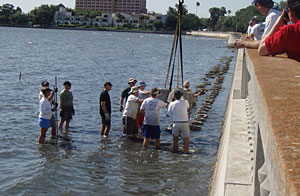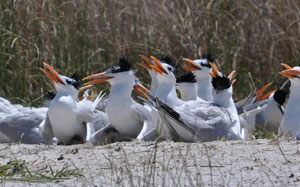[printfriendly]
District Sets New Deadlines for Community Education Grants

Applications will be available April 1 for the Southwest Florida Water Management District’s Community Education Grant program, which offers reimbursement up to $7,500 to help create hands-on, educational experiences that lead to the conservation and protection of Florida’s water resources. Individuals, community groups, volunteers, government and nongovernment agencies can apply. Community education grants are designed to target adult audiences through projects such as water body cleanups, aquatic plantings, educational workshops and more. Project activity can begin November 1, 2012, and must be completed by July 31, 2013. Applications are due Thursday, May 31, 2012. For more information, visitwww.WaterMatters.org/CommunityGrants.
Splash! grants for teachers also will be awarded for 2012-13; applications are due Sept. 2. Visithttp://www.swfwmd.state.fl.us/education/schoolgrants/dates.php for additional information.
Friendly Fungi Help Control Fire Ants, Mosquitoes
Modified fungi created by the University of Florida shows promise as weapons against fire ants, mosquitoes and other pests. In fire ants, the modified fungus was five to eight times as effective and also disrupted the ants’ tendency to remove dead ants from their nests.
“Potentially, it’s important because if you can disrupt this behavior, you may be able to increase the efficacy of the fungus in the nest, because they won’t take the dead out and you can spread the infection throughout the nest better,” said Nemat Keyhani, a UF associate professor of microbiology and cell science and the study’s lead author.
Keyhani also led a research team in a similar study of mosquitoes, testing a modified fungus that stops the insects from producing a crucial digestive enzyme. It reduced the survival time of the mosquitoes by 25%, and resulted in female mosquitoes laying 40% fewer eggs.
Mortality levels will need to be increased before the fungi are ready for widespread use, but the ability to show that the modified fungus can target a specific insect population is important. Although lethal to fire ants, the friendly fungi had no impact on another insect used as a control.
Shorebird Alliance Enlisting Volunteers Early

Warm winter weather is apparently causing shorebirds to begin nesting early, according to reports from volunteers with St. Petersburg Audubon Society who work as stewards at Fort DeSoto Park protecting the sanctuary from human visitors.
“Things seem to be gearing up a little early this year,” notes Saskia Janes, volunteer coordinator for the Suncoast Shorebird Partnership. “Official stewarding season will begin in May, however we may need a few volunteers on holiday weekends like Easter, Mother’s Day and during college spring break weeks.”
Stewards are needed at Fort DeSoto as well as Egmont Key, Shell Key, Indian Shores and Honeymoon Island. For more information, see the Summer 2011 issue of Bay Soundings or email bnb@stpeteaudubon.com.
Restore America’s Estuaries Launches Wetlands Carbon Blog

Restore America’s Estuaries has created a new blog (www.estuaries.org/blog.html) dedicated to exploring the role coastal wetlands play in sequestering greenhouse gases and reporting news and research behind national and international “Blue Carbon” efforts.
While it is well known that forest ecosystems store large amounts of the greenhouse gas carbon dioxide, promising new research is focusing on so-called “Blue Carbon” in coastal wetland ecosystems such as estuaries, mangroves, seagrasses and salt marshes.
Recent findings suggest that coastal wetlands may sequester and store carbon at rates three to five times greater than temperate forests. “Coastal tidal wetlands sequester carbon dioxide at impressive rates, primarily in the soil. Preserving and restoring coastal wetlands can be part of the solution to reducing greenhouse emissions that fuel global warming and climate change,” said Steve Emmett-Mattox, RAE’s senior director of strategic planning and programs.
Among RAE’s goals is the creation of a national greenhouse gas offset protocol for coastal tidal wetlands. Such a protocol would help bring coastal wetlands into international carbon markets, providing new opportunities and incentives for private and public investment in the restoration and preservation of tidal wetlands, and a new tool for global coastal and marine conservation. RAE will hold its annual conference at the Tampa Convention Center Oct. 20-24.
Could Hatcheries Cost Fish Ability to Survive in Wild?
A new study indicates that the impact of a hatchery environment on steelhead trout may cost fish the natural ability to survive in the wild. The findings, published in Proceedings of the National Academy of Sciences, surprised researchers by the pure speed at which hatchery fish seem to evolve.
“We’ve known for some time that hatchery-born fish are less successful at survival and reproduction in the wild, — said Michael Blouin, a professor of zoology at Oregon State University. “However, until now, it wasn’t clear why. What this study shows is that intense evolutionary pressures in the hatchery rapidly select for fish that excel there, at the expense of their reproductive success in the wild.”
The study was the result of a 19-year analysis of steelhead trout in Oregon’s Hood River. The challenge now is to see if this story is similar in other fish species, identify the genetic traits that evolve, and work to slow that rate of domestication.
DEP Designates 250th Clean Marina
Sarasota Yacht Club has been named the 250th Clean Marina in the state, joining 37 in the Tampa Bay region that already have earned the designation recognizing their commitment to protecting Florida’s waters and natural resources.
The Clean Marina program (see Bay Soundings, Summer 2004) requires that marinas evaluate their operations, implement a series of environmental housekeeping measures specific to their site and educate boaters on ways to minimize impacts. After completing the application, an on-site visit confirms that the marina meets the program’s stringent standards.
For a list of local facilities who have earned the Clean Marina designation, visithttp://www.dep.state.fl.us/cleanmarina/marinas.htm.
[su_divider]Originally published Winter 2012